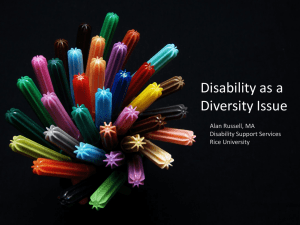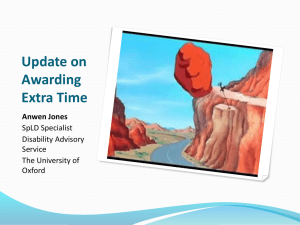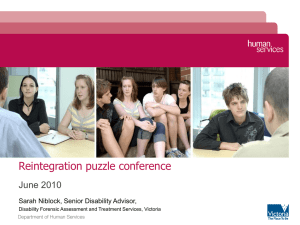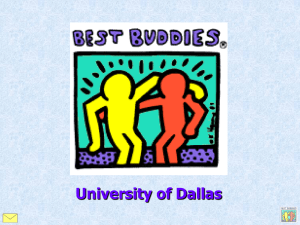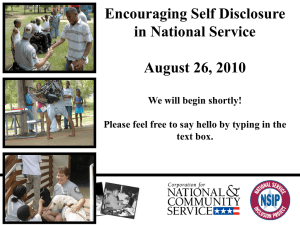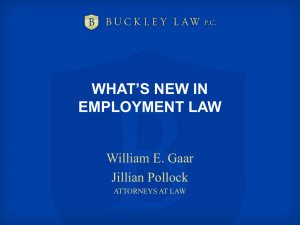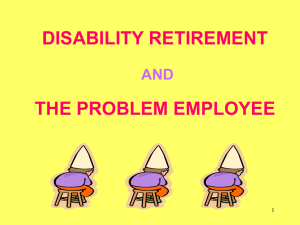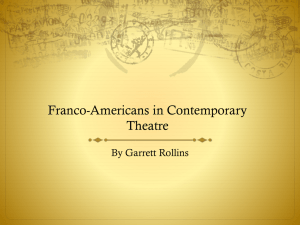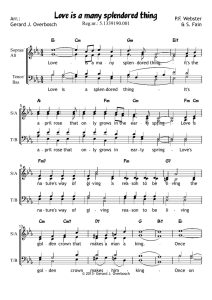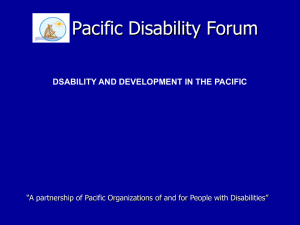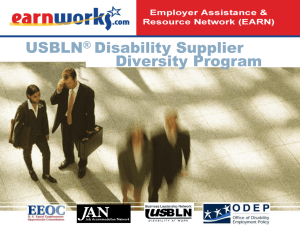Lecture slides - Melbourne Social Equity Institute
advertisement
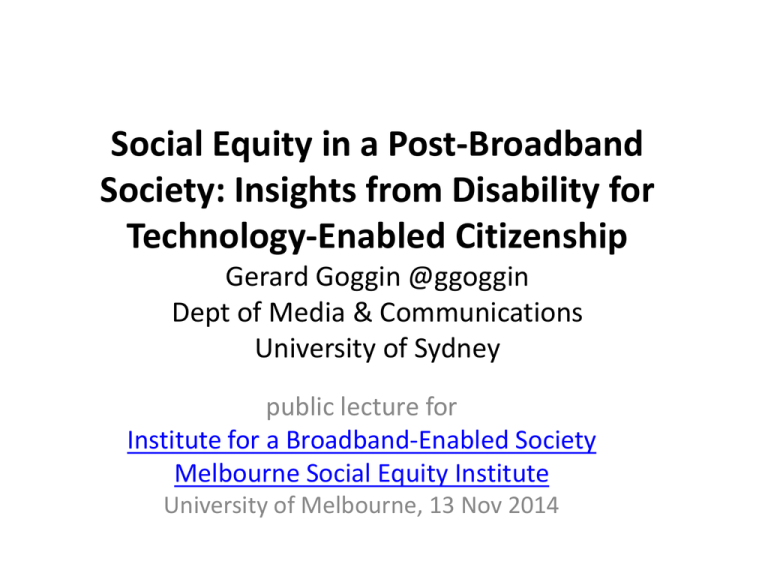
Social Equity in a Post-Broadband Society: Insights from Disability for Technology-Enabled Citizenship Gerard Goggin @ggoggin Dept of Media & Communications University of Sydney public lecture for Institute for a Broadband-Enabled Society Melbourne Social Equity Institute University of Melbourne, 13 Nov 2014 idea of lecture • how we imagine society and technology, and especially technology-enabled citizenship today? • and what does social equity look like in 2015, in what we might term a ‘post-broadbandsociety’? • Disability offers us important insights for a new approach Research for this lecture • Lecture draws on various Australian Research Council funded projects • ARC Future Fellowship on disability, human rights, and digital technology • ARC Discovery project on Internet histories in Australia and Asia Pacific • ARC Discovery project on mobile Internet policy our technological society Most of us live in a society, which revolves around, is shaped by, and is even predicated on technology. wide view of technology techniques, tools, systems, objects, artefacts, infrastructures, networks • planes, roads, bikes, strollers, wheelchairs • garden & farm tools, milking machines, cheese factories, solar power, coal seam gas • health, medical & hospital technology, pharmaceuticals, mobile health apps • print, radio, TV, screen print, digital art & design, Internet, mobiles, Internet of things technology & citizenship possibilities of our lives intimacies we nurture & cherish ways that we exercise citizenship in our communities (locally, nationally & internationally) have a strong relationship with technology citizenship under technological conditions 1. 2. technology is how we practice politics technology is the setting in which citizenship is defined Darrin Barney Canadian political philosopher imagining the good life with technology • Visions of the good life, the just, inclusive, and genuinely participatory society, the economically productive and efficient citizen, the democratic polity, have for many decades been expressed globally through how we imagine technology • Australia has now generated its own distinctive versions of such technology dispensations — each featuring its own authorizing narratives, particular new technology, and the reshaping of accompanying social relations Imagining the good life with technology • increasingly such strong ideas about technology & social life - ‘social imaginaries’ (Charles Taylor) of technology - are influential (even when ideas about technology are really just a way of working out social contradictions or changing social & power relations; e.g. Technology as ‘congealed social relations’ [Bruno Latour] • In terms of the realities of tech & society (& equity & democracy) technology-enabled citizenship needs thinking about & doing – not least to clarity what it means some histories of imagining technology & good life in Australia Overland Telegraph Wireless (radio) in Australia – AWA as public/private partnership (Jock Given) public telephone system ‘clear across Australia’ (Ann Moyal, Clear Across Australia; national numbering plan of 1959) Telecom 2000 Digital Radio Concentrator Systems (DRCS) for rural telecommunications – Australians as canny ‘inventors’, ‘adopters’, ‘tinkerers’ the information society Commission for the Future (1985-1998) technology in the counterculture (e.g. Aquarius festival, Nimbin, cf. 1973) telecommunications competition and privatization the rise of the Internet and media convergence broadband dreaming (early 1990s to early 2010s) the invention of WiFi (CSIRO; Katrina Jungnickel, DIY WiFi: Re-Imagining Connectivity) mobile & social media & e-democracy & e-gov & m-gov smart cities & the sensor society the sharing economy internet rights Thewhere 19th century Telegraph did Overland the NBN come from? online in the wilderness – early internet in Northern NSW, with Pegasus, one of 1st ISPs Ian Peter online at Terania Creek (Photo: Brian Alexander) 12 Broadband dreaming 1993-1995 - Broadband Services Expert Group, early 2000s - everyday broadband becomes reality in many Australian households (shift from dial-up); WiFi in households 2006 onwards – ‘broadband backwater’ -malaise of a poorly networked nation 2006 onwards – mobile broadband, smartphones, tablets, apps 2008 – National Broadband Network (NBN) 2008 onwards – what to do with NBN? (learning to love/use the NBN; see Wilunga study of Melissa Gregg & Jason Wilson; Michael Arnold, Bjorn Nansen, Rowan Wilken & Martin Gibbs’ Brunswick research) 2009 – filtering the NBN – the rise of Internet freedom & rights 2010 onwards – where does mobile fit into NBN (see Middleton & Given’s work) 2013 – Coalition’s NBN 2014+ - NBN as one big part of puzzle post-broadband (bb) society • The idea of broadband – its social imaginaries - in Australia has shifted • Data capacity, capability, speed, infrastructure, connectivity – still crucially important • Access vital; still not delivered • Not just one iconic infrastructure – NBN; but many • Not just one device – PC or mobile – but many; mobile Internet is an ecology • IBES-funded research has been important in fleshing out this understanding – e.g. Brunswick study Arnold, M., Apperley, T., Nansen, B., Wilken, R., & Gibbs, M. 2014. 'Patchwork Network: Spectrum Politics, The Digital Home, and Installation of the National Broadband Network', in J. Choudrie and C. Middleton (eds), Management of Broadband Technology Innovation, New York, Routledge: 25-42 • but, with the range of digital technologies – especially various forms of mobile Internet – it’s worth thinking about how we imagine technologyenabled citizenship in a post-broadband (dreaming) society Post bb – mobile Internet, for instance • Smartphones, mobile broadband, apps, game consoles, locative media, social media platforms (e.g. Facebook, QQ, Weibo) that span mobiles & Internet • Face of Internet is being reshaped in the global south – where mobile Internet is reflex, first way to access Internet • • Gitau, Shikoh, Marsden, Gary, & Donner, Jonathan. (2010). After access – Challenges facing mobile-only internet users in the developing world. Proceedings of the 28th international conference on human factors in computing systems (CHI 2010) (pp. 2603-2606). New York: ACM Jonathon Donner, The mobile internet and inclusion in the developing world, MIT Press, forthcoming • Reveals that we need to think ‘after access’ – the different gradations & modalities of pricing & affordability, affordances/capabilities of devices, contexts of use, literacy, languages, and so on • Work of Catherine Middleton on mobiles & consumers in Canada shows many of the kinds of issues that need to be addressed as part of fairness in marketplace – but simply aren’t • An important Australian study that raises these issues in Justine Humphrey’s ACCAN funded study on homelessness – shows homeless as big mobile Internet users, but struggle with cost, power for charging, & range of issues – see Homeless and Connected (2014) Disability insights for post bb society • Disability is multi-faceted area of social identity, embodiment, lived experience, social & cultural participation, democracy & social justice • Disability & digital technology is crucial area • Often thought to be about access (in narrow sense) – e.g. web accessibility (important; not yet delivered – e.g. current Coles website accessibility human rights complaint Disability insights for post bb society • Yet disability ‘after access’ is much richer, more complex • Involves design & innovation • Involves affordability • Involves participatory policy • Technology could be enabling (e.g. ‘m-enabling’ conferences/discourse) • New provisions of UN Conventions on Rights of Persons with Disability extend our ideas about technology-enabled citizenship & rights ‘States Parties shall take all appropriate measures to ensure that persons with disabilities can exercise the right to freedom of expression and opinion, including the freedom to seek, receive and impart information and ideas on an equal basis with others and through all forms of communication of their choice… (CRPD, UN, 2006, Article 21) a. Providing information intended for the general public to persons with disabilities in accessible formats and technologies appropriate to different kinds of disabilities in a timely manner and without additional cost; b. Accepting and facilitating the use of sign languages, Braille, augmentative and alternative communication, and all other accessible means, modes and formats of communication of their choice by persons with disabilities in official interactions … d. Encouraging the mass media, including providers of information through the Internet, to make their services accessible to persons with disabilities; (CRPD, UN, 2006, Article 21) Disability – technology in everyday life • After/beyond Access to tech – reasons to suggest access remains major problem – meanings of access need to be thought about/discussed in their complexity, especially when it comes to design • Accessibility of tech – bound up with access; also a major, ongoing problem – e.g. web accessibility is perhaps the best known area of effort & policy (e.g. National Transition Strategy) – yet many govt & private websites remain inaccessible; and mobile web/device accessibility of websites is still not a major goal – a key issue is the proliferation of technology, devices, software, etc; this implies that accessible interfaces are crucial, as a translation zone between technology (e.g. accessible operating systems like the Apple OS on its computers, smartphones, and tablets) Exchange Telstra blog, 1 May 2014 Problems: everyday technology • Disability still an ‘add-on’ in much technology; inclusive design approaches still have a long way to go • the technology market has been remarkable, but the ‘business’ of technology for disability often lacks (perceived) profitability • Business cultures still often lack in understanding opportunity for disability innovation disability tech policy framework: current elements • Community informatics, technology in civil society – responsibility: NGOs, peak bodies, limited govt & private funding • Statistics & research – little systematic & publicly available responsibility: Australian Institute of Health and Welfare; agencies (esp. now NDIS); regulators (e.g. ACMA – Aust Communications & Media Authority); NGOs providing much (e.g. ACCAN – Aust Communications Consumer Action Network, Media Access) also industry associations • Social media platforms – responsibility: social media companies such as Facebook, Twitter, Google Disability tech policy framework • Innovation policy -- is existing national policy adequate? - What are specific disability aspects to innovative? (e.g. case of Google Glass) – what can economic incentives to innovative with disability & technology, esp. for social policy purposes? - What are new business models underpinning wearables or driverless cars? – where does disability/accessibility fit into/get supported by these? Disability tech policy framework • The disability design turn – design as crosscutting area of focus for disability, justice, participation – doing diversity differently – Graham Pullin, Disability Meets Design (MIT, 2009) – Jos Boys, Doing Disability Differently (Routledge, 2014) – Catherine Bridge (UNSW)’s work Disability insights for post broadband tech citizenship • Comprehensive and articulated across major policy areas & life domains for technology – UN CRPD good starting point • Cross-referenced against, articulated via, social policy objectives • Proper research base and statistics on technology & disability • Support for inclusive design approaches • Important of co-design, participatory design, users involvement in design references Katie Ellis, Gerard Goggin & Beth Haller eds., Routledge Companion to Disability and Media, 2016 Katie Ellis and Gerard Goggin. ‘Disability, Locative Media, and Complex Ubiquity.’ In Ubiquitous Computing, Complexity and Culture, edited by Ulrik Ekman et al (Routledge, 2015) Katie Ellis & Gerard Goggin. Disability and the Media (Palgrave, 2015) Gerard Goggin. ‘Disability, Digital Technology, and Communication Rights: Another Legacy of the World Summit on the Information Society (WSIS)?’, forthcoming Gerard Goggin, ‘Disability and Mobile Internet’, forthcoming Gerard Goggin. ‘Innovation & Disability.’ M/C: Media and Culture 11.3 (2008) Gerard Goggin and Christopher Newell. ‘The Business of Digital Disability.’ The Information Society 24.2 (2007): 159-168. Further reading Gerard Goggin, Mark McLelland, Haiqing Yu, & Kwangsuk Lee et al. Asia Pacific Internets: Culture, History, Technology, forthcoming Gerard Goggin & Mark McLelland, eds. Global Internet Histories (Routledge, 2016) Gerard Goggin, Global Mobile Media (Routledge, 2011) Goggin, Gerard. “Mobile Web 2.0: . In Theories of the Mobile Internet: Materialities and Imaginaries, edited by Jan Hadlaw, Andrew Herman, and Thom Swiss. New York: Routledge, 2015, 134-148. Gerard Goggin & Christopher Newell, Digital Disability: The Social Construction of Disability in New Media (2003, Rowman & Littlefield) Katie Ellis and Gerard Goggin. ‘Disability, Locative Media, and Complex Ubiquity.’ In Ubiquitous Computing, Complexity and Culture, edited by Ulrik Ekman et al (Routledge, 2015) Katie Ellis & Gerard Goggin. Disability and the Media (Palgrave, 2015) Gerard Goggin. ‘’Communication Rights and Disability Online: Policy and Technology after the World Summit on the Information Society (WSIS)”, Information, Communication & Society, forthcoming Gerard Goggin, ‘Disability and Mobile Internet’, forthcoming Katie Ellis, Gerard Goggin & Beth Haller eds., Routledge Companion to Disability and Media, forthcoming
